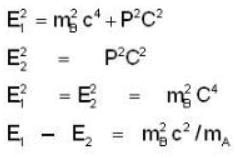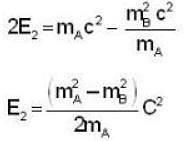Physics Exam > Physics Questions > A particle A of mass mA decays into two parti...
Start Learning for Free
A particle A of mass mA decays into two particles, one of which is B with mass mB and the other massless. The magnitude of the momentum of particle B using relativistic kinematics in the first-frame of the particle A is
- a)

- b)

- c)

- d)

Correct answer is option 'B'. Can you explain this answer?
| FREE This question is part of | Download PDF Attempt this Test |
Verified Answer
A particle A of mass mA decays into two particles, one of which is B w...

According to law of conservation of linear momentum. The momentum of particle B and massless particle are equal in magnitude and opposite is sign. Let their momentum be p.


Momentum of particle B is rest frame of particle a is same as that of massless particle

Most Upvoted Answer
A particle A of mass mA decays into two particles, one of which is B w...

According to law of conservation of linear momentum. The momentum of particle B and massless particle are equal in magnitude and opposite is sign. Let their momentum be p.


Momentum of particle B is rest frame of particle a is same as that of massless particle


|
Explore Courses for Physics exam
|

|
A particle A of mass mA decays into two particles, one of which is B with mass mB and the other massless. The magnitude of the momentum of particle B using relativistic kinematics in the first-frame of the particle A isa)b)c)d)Correct answer is option 'B'. Can you explain this answer?
Question Description
A particle A of mass mA decays into two particles, one of which is B with mass mB and the other massless. The magnitude of the momentum of particle B using relativistic kinematics in the first-frame of the particle A isa)b)c)d)Correct answer is option 'B'. Can you explain this answer? for Physics 2024 is part of Physics preparation. The Question and answers have been prepared according to the Physics exam syllabus. Information about A particle A of mass mA decays into two particles, one of which is B with mass mB and the other massless. The magnitude of the momentum of particle B using relativistic kinematics in the first-frame of the particle A isa)b)c)d)Correct answer is option 'B'. Can you explain this answer? covers all topics & solutions for Physics 2024 Exam. Find important definitions, questions, meanings, examples, exercises and tests below for A particle A of mass mA decays into two particles, one of which is B with mass mB and the other massless. The magnitude of the momentum of particle B using relativistic kinematics in the first-frame of the particle A isa)b)c)d)Correct answer is option 'B'. Can you explain this answer?.
A particle A of mass mA decays into two particles, one of which is B with mass mB and the other massless. The magnitude of the momentum of particle B using relativistic kinematics in the first-frame of the particle A isa)b)c)d)Correct answer is option 'B'. Can you explain this answer? for Physics 2024 is part of Physics preparation. The Question and answers have been prepared according to the Physics exam syllabus. Information about A particle A of mass mA decays into two particles, one of which is B with mass mB and the other massless. The magnitude of the momentum of particle B using relativistic kinematics in the first-frame of the particle A isa)b)c)d)Correct answer is option 'B'. Can you explain this answer? covers all topics & solutions for Physics 2024 Exam. Find important definitions, questions, meanings, examples, exercises and tests below for A particle A of mass mA decays into two particles, one of which is B with mass mB and the other massless. The magnitude of the momentum of particle B using relativistic kinematics in the first-frame of the particle A isa)b)c)d)Correct answer is option 'B'. Can you explain this answer?.
Solutions for A particle A of mass mA decays into two particles, one of which is B with mass mB and the other massless. The magnitude of the momentum of particle B using relativistic kinematics in the first-frame of the particle A isa)b)c)d)Correct answer is option 'B'. Can you explain this answer? in English & in Hindi are available as part of our courses for Physics.
Download more important topics, notes, lectures and mock test series for Physics Exam by signing up for free.
Here you can find the meaning of A particle A of mass mA decays into two particles, one of which is B with mass mB and the other massless. The magnitude of the momentum of particle B using relativistic kinematics in the first-frame of the particle A isa)b)c)d)Correct answer is option 'B'. Can you explain this answer? defined & explained in the simplest way possible. Besides giving the explanation of
A particle A of mass mA decays into two particles, one of which is B with mass mB and the other massless. The magnitude of the momentum of particle B using relativistic kinematics in the first-frame of the particle A isa)b)c)d)Correct answer is option 'B'. Can you explain this answer?, a detailed solution for A particle A of mass mA decays into two particles, one of which is B with mass mB and the other massless. The magnitude of the momentum of particle B using relativistic kinematics in the first-frame of the particle A isa)b)c)d)Correct answer is option 'B'. Can you explain this answer? has been provided alongside types of A particle A of mass mA decays into two particles, one of which is B with mass mB and the other massless. The magnitude of the momentum of particle B using relativistic kinematics in the first-frame of the particle A isa)b)c)d)Correct answer is option 'B'. Can you explain this answer? theory, EduRev gives you an
ample number of questions to practice A particle A of mass mA decays into two particles, one of which is B with mass mB and the other massless. The magnitude of the momentum of particle B using relativistic kinematics in the first-frame of the particle A isa)b)c)d)Correct answer is option 'B'. Can you explain this answer? tests, examples and also practice Physics tests.

|
Explore Courses for Physics exam
|

|
Suggested Free Tests
Signup for Free!
Signup to see your scores go up within 7 days! Learn & Practice with 1000+ FREE Notes, Videos & Tests.
















